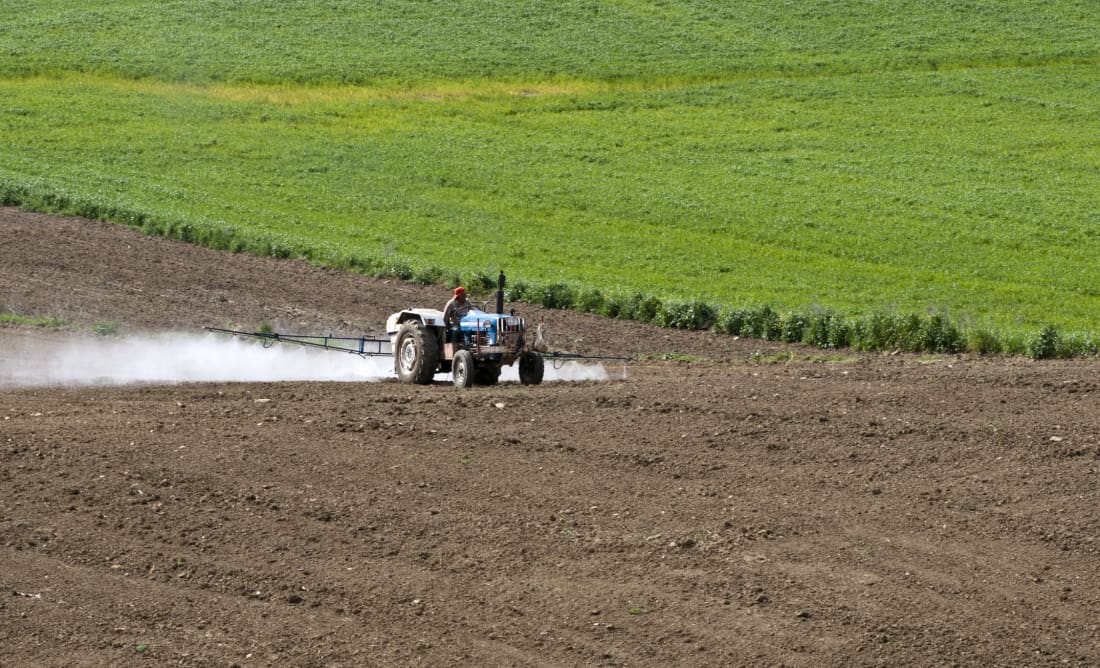
Pesticides protect crops from a variety of pests — such as weeds, diseases and insects — that can reduce crop yield. This loss is detrimental to farmers and consumers, so it’s important to be able to control these organisms. But what exactly are pesticides, and how do they work?
There are three types of pesticides — fungicides, insecticides and herbicides.
Fungicides are used for controlling fungi in the soil and air that can cause plant disease and crop failure. Insecticides are used for controlling insects that would consume the plant or its leaves, which is obviously quite detrimental to the success of the crop. Herbicides are used for controlling weeds and unwanted plant species that would use up nutrients intended for the crop.
Fungicides can be applied in the form of a liquid spray on crops in the field or as a seed coat before planting. When applied as a seed coat, the plant is protected from the risk of some common fungal diseases in the soil during germination.
Most fungicides cannot actively kill a pathogen once it has infected the plant. For this reason, it is important for farmers to apply fungicides before symptoms of the disease occur.
There are a few innovative techniques for insecticides including the use of bacterial proteins for insect control. By harnessing a toxin from a bacterium called Bacillus thuringiensis, farmers can prevent insects from feeding on plant leaves.
The Bt toxin only becomes active inside the gut of the insect, damaging the gut wall and killing the bug. Bt comes in different strains, allowing farmers to selectively target harmful insects while keeping beneficial insects safe. Insecticides are also applied in the form of a liquid spray or seed coat.
Herbicides are selective and are categorized into different groups depending on their mode of action — the biological process that causes plant death. Glyphosate is a Group 9 herbicide, meaning that its mode of action targets an enzyme in the weed to inhibit the synthesis of aromatic amino acids. Without these amino acids, the weed cannot form proteins and grow, so it will eventually die.
It can be complicated to keep track of all herbicidal modes of action as there are currently 19 groups in use, but it is crucial for farmers to understand their functions.
When the same herbicide — or one with the same mode of action — is continuously sprayed on a field for multiple years, the weeds may start to build up a resistance to it. After repeated exposure, the surviving weeds are able to adapt to the herbicide, ultimately preventing its effectiveness.
Organic producers also use a variety of herbicides on crops to control weeds. Acetic acid is popular among organic producers, allowing them to manage weed growth in crops while still maintaining an organic certification.
Herbicide resistance is an important risk to be aware of as it can change the future of agriculture by altering how farmers use herbicides to control weeds in their crops. Farmers can avoid the development of herbicide resistance by mixing different modes of action to attack weeds in more than one way. This outsmarts the weed, so it won’t be able to figure out how to protect itself.
There are many resources available to farmers, like the Guide to Crop Protection, and agronomists and chemical retail representatives can also assist farmers in choosing the right pesticides for their crops.
All pesticides used in Canada are regulated nationally under the Pest Control Products Act and Pest Control Products Regulations with the Pest Management Regulatory Agency administering this legislation to protect human health and safety and the environment by minimizing the risks associated with pesticides.
Pesticides are scientifically driven tools made to combat yield-limiting pests like weeds, insects and diseases in crops. With the proper management practices, pesticides can maintain their use in modern agriculture and help Canada continue to grow crops and produce food for people around the world.
—
Morgan Heidecker
Photo: Zaynel Cebeci / Creative Commons